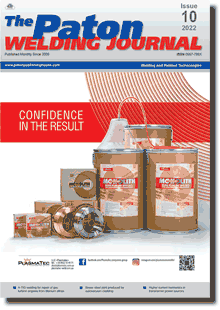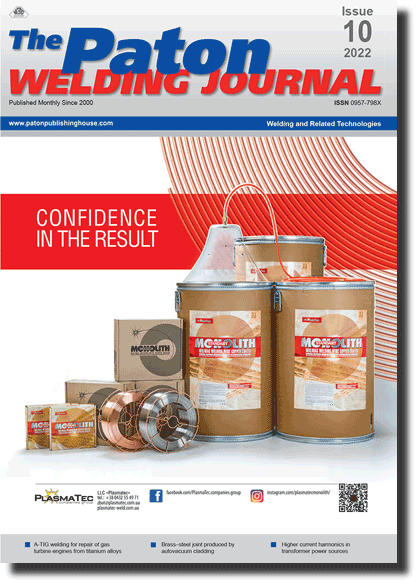| 2022 №10 (01) |
DOI of Article 10.37434/tpwj2022.10.02 |
2022 №10 (03) |

The Paton Welding Journal, 2022, #10, 13-17 pages
Effect of external electromagnetic field configuration on metal structure of welded joints of structural steel
O.D. Razmyshlyaev1, S.Yu. Maksymov2, O.M. Berdnikova2, O.O. Prylypko2, O.S. Kushnyaryova2, T.O. Alekseyenko2
1Pryazovskyi State Technical University, 7 Universytetska Str., 87500, Mariupil, Ukraine. E-mail: office@psty.edu
2E.O. Paton Electric Welding Institute of the NASU. 11 Kazymyr Malevych Str., 03150, Kyiv, Ukraine. E-mail: maksimov@paton.kiev.ua
Abstract
The peculiarities of metal structure of welded joints of structural low-alloy steel after welding using external electromagnetic field were studied. The phase composition, microstructure and microhardness of metal of welded joints produced without and with the use of alternating magnetic fields – longitudinal or transverse were studied. The structural parameters in the metal of the welds and areas of the heat-affected zone were analyzed. The conditions for producing high-quality welded joints during welding of low-alloy steels under the effect of external electromagnetic field, which provide strengthening and crack resistance of the metal, were found. 10 Ref., 1 Tabl., 4 Fig.
Keywords: structural low-alloy steel, welded joints, external electromagnetic effect, alternating magnetic fields, heat-affected zone, phase composition, microstructure, microhardness
Received: 29.08.2022
Accepted: 01.12.2022
References
1. Ryzhov, R.N., Kuznetsov, V.D., Prilipko, E.A. (2005) Calculation procedure of controlling electromagnetic effect parameters in arc welding of structural steels. Vestnik HTUU KPI, 45, 176–177 [in Russian].2. Ryzhov, R.N., Kuznetsov, V.D. (2006) External electromagnetic effects in the processes of arc welding and surfacing (Review). The Paton Welding J., 10, 36–44.
3. Ryzhov, R.N., Kuznetsov, V.D. (2005) Choice of optimal parameters of external electromagnetic action in arc methods of welding. The Paton Welding J., 6, 27–31.
4. Ryzhov, R.N. (2007) Influence of electromagnetic actions on process of formation and solidification of welds. Svarochn. Proizvodstvo, 2, 56–58 [in Russian].
5. Ahieieva, А.D. (2019) Rational using of the controlling longitudinal and transverse magnetic fields at arc welding and surfacing. IOP Conference Series: Mater. Sci. and Engin.
6. Ageeva, M.V., Razmyshlyaev, A.D. (2019) Influence of combined magnetic field on wire melting rate in arc surfacing. Tekhnichni Nauky ta Tekhnologii, 18(4), 22-27 [in Russian]. https://doi.org/10.15407/tpwj2019.01.05
7. Boldyrev, A.M., Birzhev, V.A., Chernykh, A.V. (1992) To calculation of hydrodynamic parameters of liquid metal on welding pool bottom in arc welding. Svarochn. Proizvodstvo, 2, 31–33 [in Russian].
8. Boldyrev, A.M., Birzhev, V.A., Martynenko, A.I. (2008) Examination of influence of variable axial magnetic field on process of electrode wire melting. Ibid., 2(6–8), 63, 64 [in Russian].
9. Mironova, M.V. (2013) To choice of optimal schemes of input devices of transverse magnetic field for processes of arc welding and surfacing. In: Zbirnyk Nauk. Prats of DSTU, Tekhnichni Nauky, 1(21), 74–78 [in Russian].
10. Lazarenko, M.A., Razmyshlyaev, A.D. (2000) Structure of controlling magnetic fields for welding and surfacing processes using the devices with cylindrical 304 symmetry. Visnyk PDTU, 9, 160–163 [in Russian].
Suggested Citation
O.D. Razmyshlyaev, S.Yu. Maksymov, O.M. Berdnikova, O.O. Prylypko, O.S. Kushnyaryova, T.O. Alekseyenko (2022) Effect of external electromagnetic field configuration on metal structure of welded joints of structural steel. The Paton Welding J., 10, 13-17.The cost of subscription/purchase order journals or individual articles
| Journal/Currency | Annual Set | 1 issue printed |
1 issue |
one article |
| TPWJ/USD | 384 $ | 32 $ | 26 $ | 13 $ |
| TPWJ/EUR | 348 € | 29 € | 24 € | 12 € |
| TPWJ/UAH | 7200 UAH | 600 UAH | 600 UAH | 280 UAH |
| AS/UAH | 1800 UAH | 300 UAH | 300 UAH | 150 UAH |
| AS/USD | 192 $ | 32 $ | 26 $ | 13 $ |
| AS/EUR | 180 € | 30 € | 25 € | 12 € |
| SEM/UAH | 1200 UAH | 300 UAH | 300 UAH | 150 UAH |
| SEM/USD | 128 $ | 32 $ | 26 $ | 13 $ |
| SEM/EUR | 120 € | 30 € | 25 € | 12 € |
| TDNK/UAH | 1200 UAH | 300 UAH | 300 UAH | 150 UAH |
| TDNK/USD | 128 $ | 32 $ | 26 $ | 13 $ |
| TDNK/EUR | 120 € | 30 € | 25 € | 15 € |
AS = «Automatic Welding» - 6 issues per year;
TPWJ = «PATON WELDING JOURNAL» - 12 issues per year;
SEM = «Electrometallurgy Today» - 4 issues per year;
TDNK = «Technical Diagnostics and Non-Destructive Testing» - 4 issues per year.


